The Changing Face of Divorce in the UK: Trends, Causes, and Demographics
Marriage and divorce patterns in the United Kingdom have undergone significant transformations in recent decades, reflecting broader social, economic, and legal changes. While the stereotype that “half of all marriages end in divorce” persists in popular culture, the reality is far more nuanced, with divorce rates actually showing a noteworthy decline in recent years.
In 2022, the divorce rate fell to 6.7 for men and 6.6 for women per 1,000 of the married population – the lowest rates recorded since 1971. This comprehensive analysis examines current divorce trends in the UK, investigates the most common reasons couples separate, explores demographic patterns, and considers how recent legal reforms and societal shifts are reshaping marital dissolution in Britain.
Current Divorce Rates: A Declining Trend
National Trends
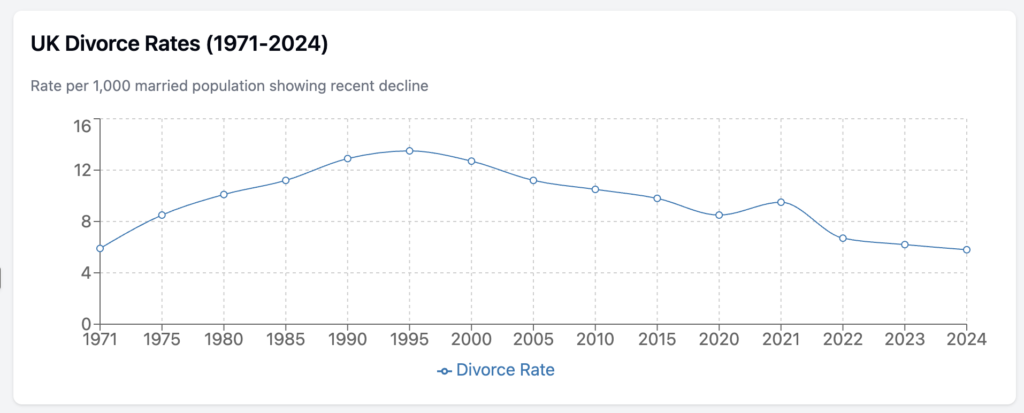
Despite popular perception, divorce in the UK has been on a downward trajectory in recent years. The 2022 divorce rates of 6.7 for men and 6.6 for women per 1,000 of the married population represented a significant drop from the 2021 rates of 9.5 for men and 9.4 for women per 1,000 of the married population.
The first quarter of 2024 saw 27,908 divorce applications made in England and Wales, which represents an 11% decrease compared to the same period in 2023. During this same quarter, 21,662 final orders were granted under the new divorce law that came into effect in 2022.
The total number of divorces in the UK has been steadily declining, with 76,089 divorces recorded in 2023 – marking the lowest point in over 50 years. This decline is particularly notable given the introduction of the No-Fault Divorce law in 2022, which some predicted might lead to an increase in divorce filings.
The Impact of Legal Reforms
The decline in divorce numbers can be partly attributed to changes in divorce law, including the Divorce, Dissolution and Separation Act 2020, which came into effect in April 2022. This introduced the No-Fault Divorce, allowing couples to divorce without citing specific reasons, while also extending the mandatory waiting period.
Under the new divorce legislation, there are now mandatory waiting periods at key stages of the divorce process. As of January to March 2024, the mean average time from application to conditional order was 41 weeks, up 3 weeks from the same quarter of 2023, while the mean time from application to final order was 68 weeks (almost 1.5 years), up 4 weeks from the equivalent period in 2023.
Joint vs. Sole Applications
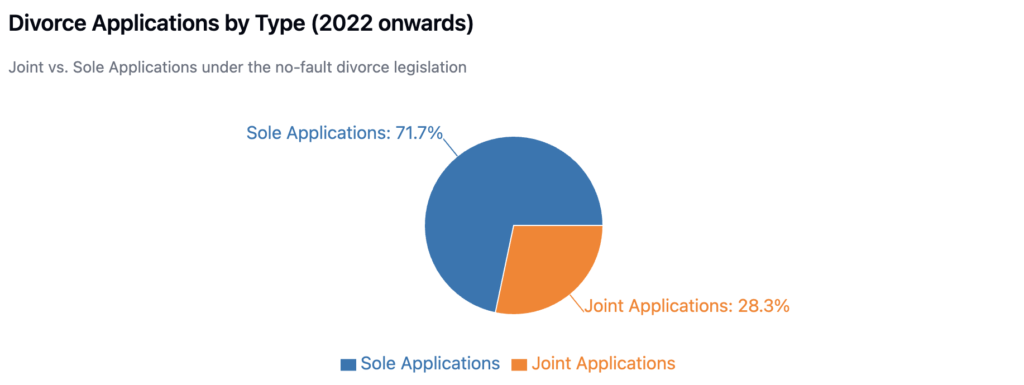
The new divorce legislation introduced the option for couples to make joint applications, reflecting a more collaborative approach to divorce. However, despite this new option, 74% of applications in early 2024 were still made by sole applicants rather than jointly by the divorcing couple. This suggests that adversarial divorces remain common despite the availability of a more cooperative legal pathway.
Factors Influencing Divorce Trends
Several interrelated factors help explain the overall downward trend in UK divorce rates:
Declining Marriage Rates
Marriage itself has become less common in the United Kingdom over recent decades. In 2023, the Guardian reported that the number of people getting married in England and Wales had reduced by more than 50% in just ten years. As fewer people marry, the absolute number of divorces naturally decreases as well.
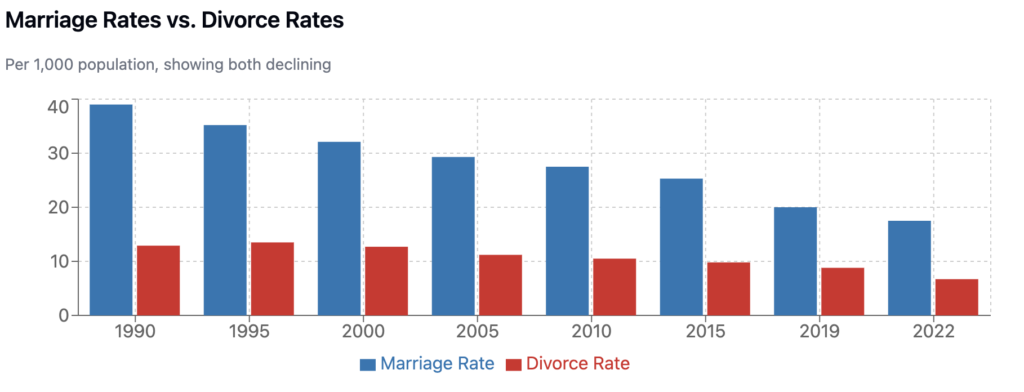
Economic Factors
Economic pressures, particularly the ongoing cost of living crisis, may be contributing to the decline in both marriages and divorces. The average cost of divorce in the UK is £14,561, making it a financially daunting prospect for many couples experiencing economic hardship.
Research by Legal & General found that financial pressures have led to more than 270,000 couples postponing their divorce since 2019. The cost of living crisis, potentially influenced by Brexit, the Russia-Ukraine war, and the COVID-19 pandemic, has made divorce financially unfeasible for many couples.
The economic environment appears to have a significant impact on divorce decisions. As one analyst noted, “The cost-of-living crisis may have deterred some couples from divorcing, although based on our experience of the 2007 financial crisis, this will probably mean divorces are delayed rather than decided against altogether.”
Social and Demographic Shifts
Societal trends may also be influencing divorce patterns. Divorces are happening later and after longer marriages, while simultaneously, cohabitation is becoming increasingly common among younger couples who might have married in previous generations.
In recent decades, cohabitation has become more common across the globe, including in the UK. The proportion of women in their teens and twenties who are married has declined significantly, while marriage rates for older women have remained relatively stable.
Geographic Variations in Divorce Rates
Divorce rates vary considerably across different regions of the UK, reflecting diverse economic conditions and social attitudes.
Blackpool has among the highest divorce rates in the UK at 12.1%, tied with Hastings. Other cities with notably high divorce rates include Lincoln, Gosport, Eastbourne, and Portsmouth. These regional variations may be attributed to economic factors, with areas experiencing greater financial hardship often showing higher divorce rates.
Geographical differences in divorce rates within the UK can be attributed to a combination of economic, cultural, and social factors unique to each region. Areas with stronger traditional values, higher religious observance, or better economic conditions typically show lower divorce rates than regions facing significant economic challenges or more liberal attitudes toward marriage dissolution.
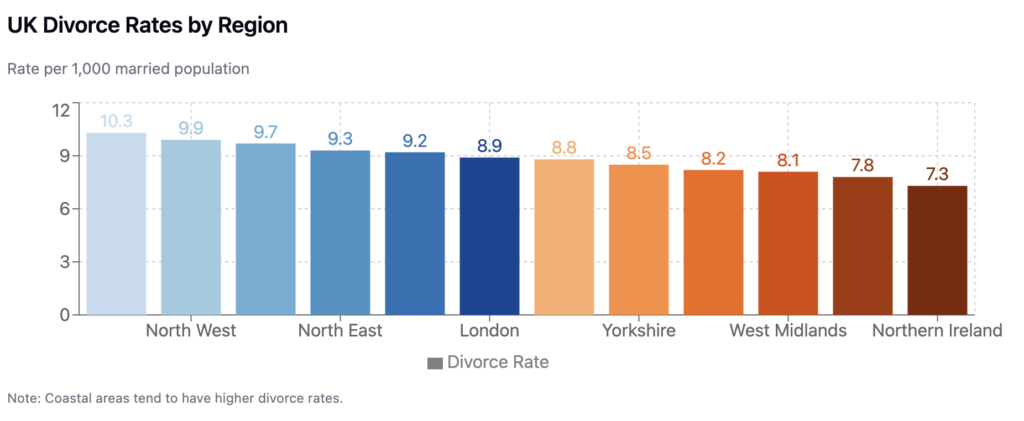
Demographic Patterns in Divorce
Divorce rates vary significantly across different demographic groups in the UK, revealing important patterns related to age, education, income, and ethnicity.
Age Factors
Recent research by the Marriage Foundation, utilizing data from Eurostat, shows that divorce rates during the first 15 years of marriage are declining across Europe, with the UK exhibiting the most substantial reduction over the past 25 years.
The statistics show that couples who married in 1992 experienced a divorce rate of 30.7% within the first 15 years of marriage. For those who married in 2002, this rate dropped to 28.1%. More recently, couples who wedded in 2017 have a projected divorce rate of just 22.5%.
This suggests that more recent marriages in the UK may be more stable than those formed in previous decades, possibly reflecting more careful partner selection, later marriage ages, or improved relationship skills among younger generations.

Education and Income
Higher education levels have been linked to lower divorce rates in the UK, possibly due to better economic stability and delayed marriage. Economic stability or instability can greatly influence the decision to divorce, with financial stress often cited as a key factor in marital breakdown.
Research using longitudinal data has found that increased net worth is associated with a lower risk of relationship dissolution, even when controlling for factors such as family income, employment status, race/ethnicity, age, education, and children in the household. This suggests that wealth – beyond just income – provides a protective effect against divorce, possibly by reducing financial stress or increasing the costs of separation.
Cultural and Ethnic Factors
Cultural attitudes towards marriage and divorce play a crucial role in the prevalence of divorce within different ethnic and cultural groups in the UK. Communities with stronger traditional family values or religious prohibitions against divorce typically show lower divorce rates, while more secularized groups may have higher rates of marital dissolution.
Within Europe, countries with strong Catholic influence typically show lower divorce rates. Slovakia, Poland, Italy, and Romania report the lowest rates, with Romania projecting a divorce rate of just 14% for couples married in 2017. By contrast, Sweden exhibits the highest projected rate at 36%. The UK falls somewhere in the middle of this European spectrum.
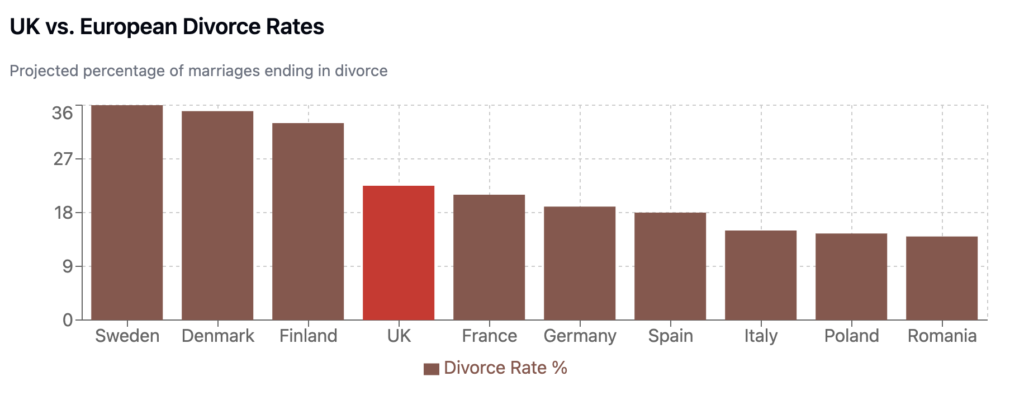
Common Reasons for Divorce in the UK
While the introduction of no-fault divorce has reduced the need for couples to cite specific reasons for their relationship breakdown in legal proceedings, research continues to identify common factors contributing to marital dissolution.
Leading Causes
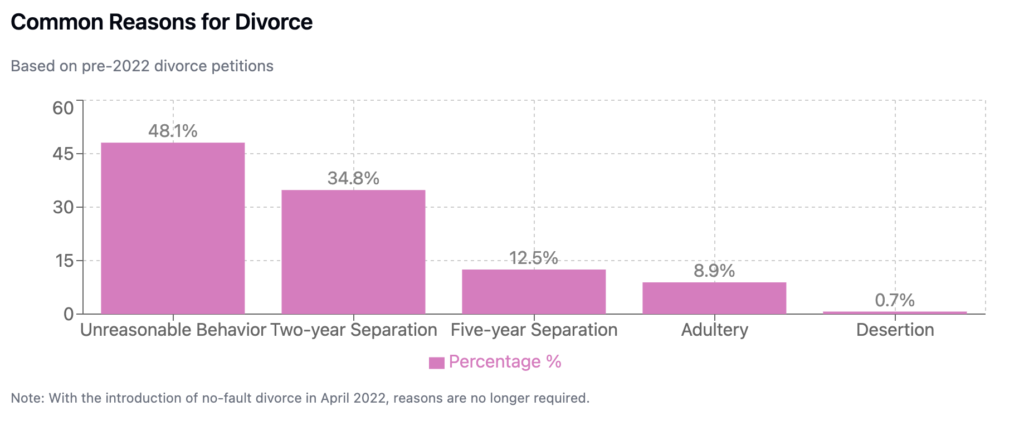
Prior to the no-fault divorce law, the most common reasons cited in divorce applications in the UK were unreasonable behavior, with this accounting for 34.8% of applications from males. This broad category can include a wide range of issues from minor disagreements to more serious problems.
While UK-specific data on reasons for divorce has become more limited with the introduction of no-fault divorce, international research consistently identifies several key factors:
- Communication breakdown and conflict: Persistent arguments and inability to resolve disagreements effectively
- Financial pressures: Disagreements about money management, financial stress, and economic hardship
- Infidelity: Extramarital affairs remain a significant cause of relationship breakdown
- Lack of commitment: Diminishing dedication to making the marriage work
- Growing apart: Couples developing different interests, values, or life goals over time
Financial Impact of Divorce
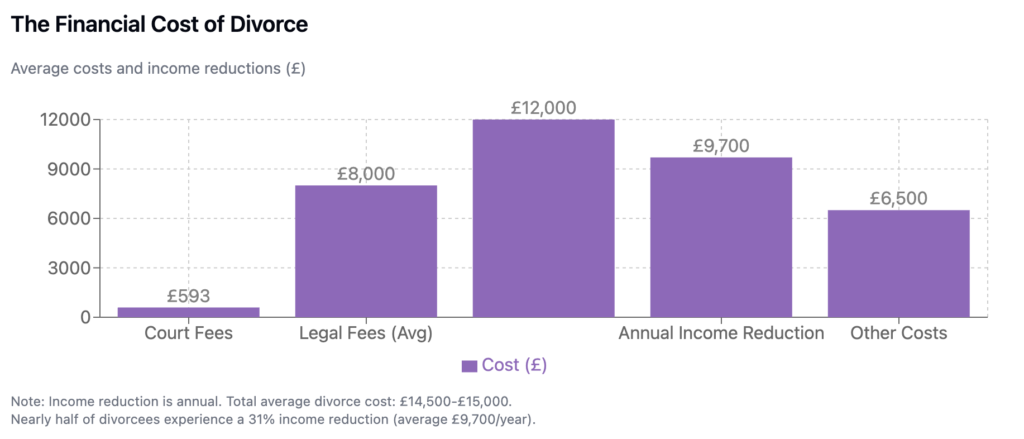
The financial consequences of divorce can be severe, with research by Legal & General finding that nearly half of divorcees experience a 31% reduction in their incomes, leaving them with an average of £9,700 less each year.
Around 40% of divorcees in the UK believe that their divorce was financially unfair, with one party coming out significantly better in terms of finances and assets. This perception of inequity can further complicate the emotional aftermath of divorce.
The financial planning aspects of divorce are often inadequately addressed, with only 20% of UK couples discussing their pensions when dividing assets during divorce proceedings, despite pensions often being one of the largest assets in a marriage.
The Changing Legal Landscape
The legal framework for divorce in the UK has undergone significant changes in recent years, most notably with the introduction of no-fault divorce.
No-Fault Divorce Reform
New divorce legislation came into effect on April 6, 2022, which aims to reduce potential conflict amongst divorcing couples by removing the ability to make allegations about the conduct of a spouse. This represents a fundamental shift away from the previous system that required couples to cite specific reasons for the breakdown of their marriage.
The new legislation introduced new terminology and mandatory waiting periods at key stages of the divorce process, significantly changing how divorces proceed through the legal system.
Processing Times
In January to March 2024, the mean average time for divorce and annulment cases to reach first disposal was 41 weeks. For new cases alone under the new legislation, the mean average time was 35 weeks.
The lengthy divorce process cannot be easily expedited, with the mean average time from divorce application to final order in the UK being 68 weeks – almost 1.5 years. These extended timeframes reflect both procedural requirements and potential backlogs in the legal system.
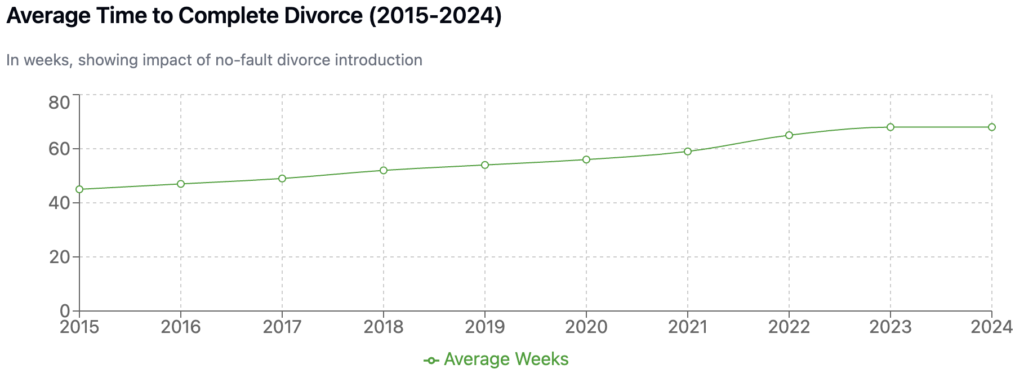
The Future of Divorce in the UK
Several trends are likely to shape the future of divorce in the United Kingdom:
Continued Impact of Economic Pressures
The ongoing cost of living crisis is likely to continue influencing divorce patterns, with financial considerations potentially delaying divorces for many couples. As economic conditions fluctuate, we may see corresponding changes in divorce rates.
Further Evolution of Legal Frameworks
The recent shift to no-fault divorce represents a significant modernization of divorce law in the UK. Further refinements to this system may emerge as courts and couples adapt to the new procedures and timeframes.
Changing Attitudes Toward Marriage
The significant decline in marriage rates over the past decade suggests changing attitudes toward formal marriage, with many couples choosing cohabitation or other relationship arrangements instead. This shift will continue to influence divorce statistics, potentially leading to fewer formal divorces even as relationships continue to form and dissolve.
Conclusion
The divorce landscape in the UK is undergoing significant transformation, with rates declining to their lowest levels in decades. This trend reflects a complex interplay of factors including decreasing marriage rates, economic pressures, legal reforms, and changing social attitudes toward relationships.
While divorce remains a significant life event for many Britons, the introduction of no-fault divorce has shifted the legal process away from assigning blame and toward a more amicable resolution. At the same time, financial considerations – particularly in the context of the ongoing cost of living crisis – are playing an increasingly important role in divorce decisions, with many couples potentially delaying separation due to economic constraints.
As we look to the future, divorce in the UK will likely continue evolving in response to broader social and economic trends. The declining divorce rate does not necessarily indicate that relationships have become more stable, but rather may reflect the changing nature of partnership itself in British society, with marriage becoming more selective and occurring later in life for those who choose it.
Understanding these complex patterns provides valuable insights for policymakers, counselors, legal professionals, and couples themselves as they navigate the changing institution of marriage in 21st century Britain.
